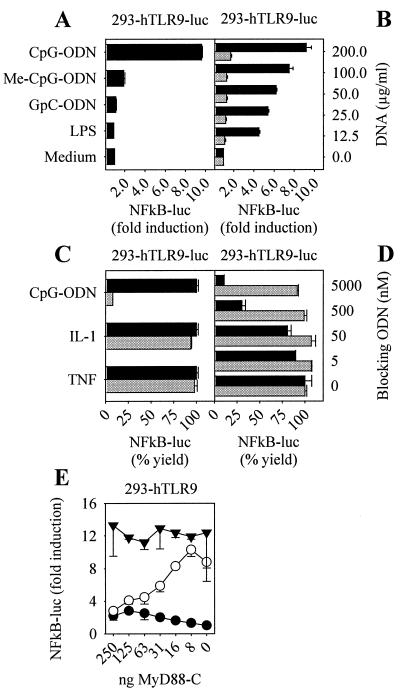Figure 3.
Stable Reconstitution with human TLR9 recapitulates CpG-DNA mechanisms of action. The 293 cells stably transfected with hTLR9 and a 6-fold NF-κB luciferase reporter plasmid (293-hTLR9-luc) were stimulated with 2 μM CpG-ODN (2006), 2 μM Me-CpG-ODN (methylated 2006), 2 μM GpC-ODN (2006-GC), 100 ng/ml LPS, or medium (A) or with E. coli DNA (black bars) or E.coli DNA digested with DNase I (gray bars) at concentrations indicated (B). After 12 h, NF-κB activation was measured (n = 2, mean ± SD). (C) The 293-hTLR9-luc cells were preincubated with 10 nM Bafilomycin A (gray bars) or DMSO control (black bars) for 30 min and stimulated with 0.5 μM CpG-ODN (2006), 10 ng/ml IL-1α, or 10 ng/ml TNF-α. NF-κB activation was monitored after 12 h and is presented as % yield (fold NF-κB activation with Bafilomycin A treatment/fold NF-κB activation with DMSO control × 100) (n = 2, mean ± SD). (D) 293-hTLR9-luc cells were incubated with 0.5 μM CpG-ODN (2006) (black bars) or 10 ng/ml TNF-α (gray bars) and increasing concentrations of a blocking ODN (see sequence in Materials and Methods) as indicated. NF-κB activation was monitored after 12 h and is presented as % yield (fold NF-κB activation with blocking ODN/fold NF-κB activation without blocking ODN × 100) (n = 2, mean ± SD). (E) The 293 cells stably transfected with hTLR9 (293-hTLR9) were cotransfected with a 6-fold NF-κB luciferase reporter plasmid and increasing concentrations of dominant negative human MyD88 expression vector at concentrations indicated. Cells were not stimulated (●) or stimulated with 2 μM CpG-ODN (2006) (○) or 10 ng/ml TNF-α (▾), and NF-κB activation was monitored after 12 h (n = 2, mean ± SD). Results are representative of at least two independent experiments.

